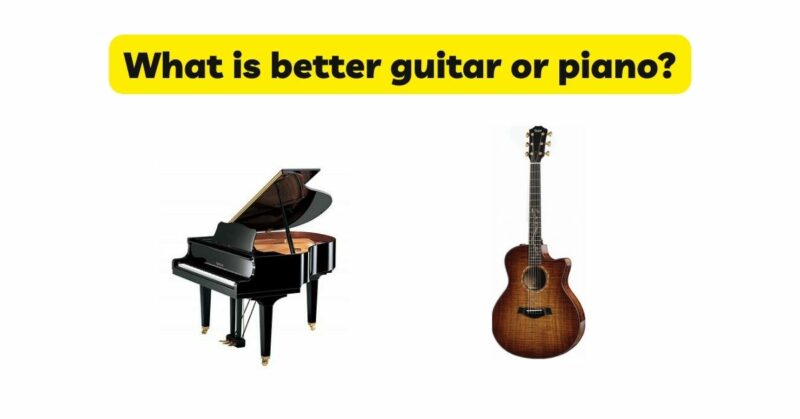The guitar and piano are two iconic instruments that have enchanted musicians and audiences throughout history. Both instruments offer unique qualities and advantages, leaving aspiring musicians pondering the question of which is better. However, determining the superiority of the guitar or piano is subjective and depends on various factors, including personal preferences, musical goals, versatility, expressive potential, cultural significance, and individual learning styles. In this article, we will explore these aspects, aiming to shed light on the debate while recognizing the inherent value and beauty of both instruments.
- Versatility: A Multifaceted Musical Exploration: Both the guitar and piano boast impressive versatility, each with its own musical palette and possibilities. The guitar’s ability to strum chords, pick melodies, and create captivating solos lends itself well to a wide range of musical genres, including folk, rock, blues, jazz, and pop. It is often associated with popular music and offers an intimate connection between the player and the instrument. On the other hand, the piano’s expansive range and polyphonic capabilities allow for simultaneous playing of melodies, harmonies, and basslines. Its versatility spans classical, jazz, and contemporary genres, offering a complete musical experience.
- Expressive Potential: Emotions Unleashed: Expressing emotions and conveying musical ideas is a fundamental aspect of playing an instrument. The guitar’s intimate connection and string resonance provide a platform for players to add personal touches through techniques such as bending, vibrato, and slides. It excels in capturing the raw emotions of blues, rock, and folk music. Conversely, the piano’s broad dynamic range, nuanced touch sensitivity, and expansive tonal palette allow musicians to explore a vast array of emotions. Its ability to play both soft, delicate passages and thunderous, powerful moments offers expressive potential across various musical genres.
- Learning Curves: Technical Demands and Learning Paths: The learning curves of the guitar and piano differ, presenting distinct challenges for beginners. Learning the piano requires precise finger coordination, hand independence, and the ability to read music in both treble and bass clefs. It provides a solid foundation in music theory, notation, and rhythm. The guitar, with its chord-based approach and fretboard navigation, appeals to many beginners due to its intuitive nature. While chord changes and finger coordination take time to master, the guitar’s accessible visual representation and simplified chord charts make the learning process more approachable.
- Cultural Significance: Honoring Musical Heritage: Both the guitar and piano carry significant cultural weight, shaped by their historical roles and associations. The piano’s legacy in classical music and its association with renowned composers evoke a sense of tradition, elegance, and musical excellence. It stands as a symbol of refined artistry and has played a profound role in the development of Western music. Conversely, the guitar’s popularity spans across various musical genres, including blues, rock, jazz, and folk. It represents rebellion, self-expression, and the spirit of creativity, shaping popular culture and contemporary music.
- Personal Preferences and Musical Goals: Determining which instrument is better ultimately depends on personal preferences and musical goals. The choice should be guided by the individual’s interests, musical tastes, and aspirations. Some individuals may resonate more with the guitar’s versatility, portability, and connection to popular music genres. Others may be drawn to the piano’s expressive power, extensive repertoire, and classical associations. Understanding personal preferences and aligning them with musical goals ensures a fulfilling and rewarding musical journey.
- Cultural Context: Instrumental Roles and Ensembles: Considering the role of each instrument within different musical contexts is essential. The guitar’s rhythmic strumming, melodic accompaniment, and solo capabilities make it a versatile instrument for solo performances, as well as ensemble playing in bands and small ensembles. Its ability to accompany vocals adds to its appeal as a singer-songwriter’s instrument. Conversely, the piano’s versatility as both a solo and ensemble instrument makes it suitable for various settings, including solo recitals, chamber music ensembles, and orchestral performances.
- Individual Learning Styles and Motivation: Understanding individual learning styles and sources of motivation is vital in selecting the instrument that will lead to a rewarding learning experience. Some individuals may be drawn to the piano’s structured approach, gradual progress, and focus on technique and music theory. Others may find the guitar’s more informal and immediate style of learning more engaging, relying on a combination of chords, tablature, and ear training. Reflecting on preferred learning styles, whether through formal instruction or self-teaching, will ensure a more enjoyable and productive musical journey.
- Musical Collaboration and Exploration: It is worth noting that the guitar and piano can complement each other in musical collaborations and exploration. Learning one instrument does not preclude the opportunity to explore the other in the future. Many musicians find joy and benefit from learning multiple instruments. Incorporating both instruments into your musical repertoire broadens musical horizons, fosters creativity, and enhances the ability to communicate with other musicians in diverse settings.
Conclusion: The question of which instrument is better, the guitar or piano, is ultimately a matter of personal preference, musical goals, and individual inclinations. Both instruments possess unique qualities, offer versatile musical exploration, and have significant cultural significance. The guitar’s intimacy, versatility, and connection to popular music genres resonate with many musicians, while the piano’s expressive power, extensive repertoire, and refined elegance appeal to others. Understanding personal preferences, aligning them with musical aspirations, and acknowledging the inherent value of both instruments allows for a more inclusive and appreciative perspective. Ultimately, the beauty lies in the harmony and diversity of musical expression that both the guitar and piano offer to musicians and audiences alike.


